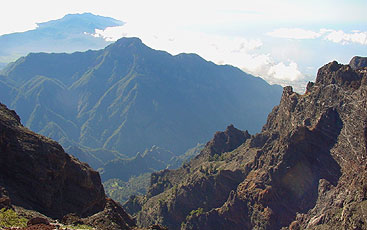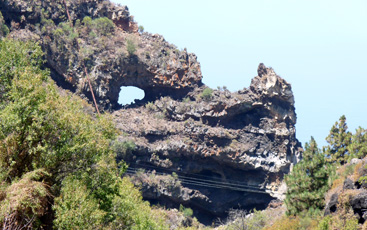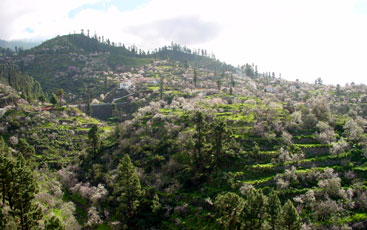
La Palma
Green pearl in the Atlantic Ocean

- View from Roque de Los Muchachos into the Caldera De Taburiente and to the Ridge of the Southern Volcanoes
Wonderful landscapes, high mountains, impressive gorges, wildly romantic valleys, the wonderful starry sky and the almost untouched nature will inspire you. In the northwest of the Canary Islands archipelago lies the island of La Palma. Particularly outstanding are the Caldera de Taburiente, one of the world's largest erosional craters, the breathtaking Barranco del Agua in the area of the UNESCO biosphere reserve Los Tilos, as well as the bizarre volcanic landscape with the young Volcan de Teneguia in the south of this mystical fire island.
More photos of La Palma can be found in our gallery.
The Caldera De Taburiente
Wild water and an archaic primeval landscape
The Caldera de Taburiente is one of the most spectacular and largest erosion craters in the world. The razor-sharply jagged crenellations of the crater wall reach almost 1700 metres into the sky up to the highest elevation of the island, the Roque de los Muchachos with a height of 2426 metres.

- Rhino shaped Natural Monument near Tijarafe
Inside the crater, which is almost 10 km in diameter, wild streams, colourful waterfalls and an evergreen natural landscape dotted with deep gorges await you. On the western side of the Caldera, the enormous canyon of the Barranco de las Angustias opens up to the sea. This valley, with its original wild river character and the sometimes only a few meters wide course between huge boulders, is in itself an impressive natural beauty. A visit to this National Park combined with a walk into the Caldera offers you an unforgettable experience.
The Barranco Del Agua
Pure nature in the fairytale cloud forest of Los Tilos
Situated in the middle of the laurel forest wilderness, the Barranco del Agua belongs to the biosphere reserve El Canal Y Los Tilos, established by UNESCO in 1983.
An excursion to the reserve gives you an impression of the wildlife and lush jungle landscape of the northeast like no other area. Due to the north-eastern trade wind, the island's largest water in this area is drained, ensuring that the largest laurel forest in the Canary Islands is home to a diverse vegetation with huge ferns and climbing plants. The dampness of the clouds accumulating on the slopes of Los Tilos let lichens grow on the trees, which enchant this wilderness of gorges. The vertical, partially overhanging cliffs of the Barranco del Agua are up to 500 metres high. At the narrowest places, only 2 meters wide, one can often only recognize a narrow blue stripe of the sky at the top. The horizontal grooves and gouges on the cliffs of the gorge give an idea of the force with which the water masses break their way into the sea after heavy rainfall.
A visit to Los Tilos is an absolute must for nature lovers.
The Volcan De Teneguia
Discoveries full of contrasts and a still hot volcano
The south of the island is dominated by a fantastic mountain range, the Cumbre Vieja, formed by more than 130 volcanoes, which stretches from north to south over half of the island at altitudes of up to 2000 metres and of which the Volcan de Teneguia, last erupted in 1971, is the youngest mountain of fire in La Palma. Climbing it means the smell of sulphur and heat that still escapes from fumaroles on the flanks. The torn lava landscape of the surrounding area is one of the most magnificent areas of the island and captivates with constantly changing colours. Here black moonscape, there the intense green of young pine trees. Red tuff-rock alternates with almost park-like landscapes created by nature. The blue of the Atlantic Ocean and the white of the salt flats give this ensemble of colours and shapes a view that is one of the most beautiful things La Palma has to offer.
The Municipality of Puntagorda
Picturesque village between almond trees and pine forests

- Almond Blossom near Puntagorda
The sunny district town of Puntagorda is situated in the northwest of La Palma and is surrounded by a green, charming environment. It is one of the most beautiful places on the island, with its small white houses surrounded by dragon tree groves, almond trees and magnificent Canarian pine forests. Depending on the season, a wave of flowers and colours surges around the village, creating new views of the surrounding countryside. Artists, craftsmen and painters also feel attracted by the light and the beautiful varied landscape around Puntagorda. Most of the inhabitants work in agriculture, because the soil is very fertile. The products are offered every week at the farmer's market in the market hall of Puntagorda. Once a year between the end of January and the beginning of February there is the famous almond blossom festival, where visitors from all parts of the island celebrate and dance to local music until the early morning. At the harbour of the village there is a small natural swimming pool, which invites you to a bath in the sea. Here the clocks tick a little more leisurely than in other areas.
